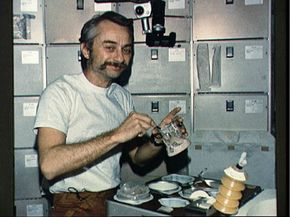Cooking and Growing Food in Space
The space shuttle's kitchen doesn't need to be too extravagant because most of the foods are practically ready to eat. A small galley in the shuttle's middeck houses a rehydration station that dispenses hot and cold water for rehydrated foods and drinks. Astronauts use the forced air convection oven to heat the meals that need warming.
It takes about 20 to 30 minutes to reconstitute and heat a meal. Each astronaut has a meal tray that holds the food containers. The tray can be attached to either the astronaut's lap or a wall. After the meal, the containers are placed in a trash compartment that sits underneath the middeck floor. Astronauts clean eating utensils and trays with pre-moistened, sanitized towelette.
Advertisement
Because today's astronauts usually stay in space for several weeks or months, at most, they're able to carry all the food they'll need onboard. But in the future, space missions could be significantly extended. To get to NASA's intended destination -- Mars -- and back again will take two years. Astronauts will need to carry foods that have a three to five year shelf life. They'll also need to start growing their own foods.
NASA plans to grow fruits and vegetables on space farms -- greenhouses that are temperature-controlled, artificially lit and employ a hydroponic system, which uses nutrients instead of typical soil. Crops might include soybeans, peanuts, spinach, cabbage, lettuce and rice. Wheat berries and soybeans can be grown and processed into pasta or bread. The astronauts would then prepare these foods into home-cooked meals in a galley kitchen. According to NASA, a sample Martian dinner menu might include spinach and tomato crouton salad, wheat pasta with tomato sauce and a chocolate peanut butter soymilk shake.
To find out more about space food and related topics, visit our links page.
Related HowStuffWorks Articles
More Great Links
Sources
- "Aromas and Odors in Space and their Effect on Appetite." Iowa State University. http://www.ag.iastate.edu/centers/ftcsc/media/205b.html
- "Bone Loss in Space." Iowa State University.http://www.ag.iastate.edu/centers/ftcsc/media/302k.html
- "Chinese Space Food to Hit Supermarket Shelves." Associated Press.http://www.space.com/news/ap_070724_china_spacefood.html
- "Food for Space Flight." NASA. http://spaceflight.nasa.gov/shuttle/reference/factsheets/food.html
- "Fresh Fruits and Vegetables in Space." Iowa State University.http://www.ag.iastate.edu/centers/ftcsc/media/103k.html
- "Fresh Nutrition Inside the Space Suit." Iowa State University.http://www.ag.iastate.edu/centers/ftcsc/media/205k.html
- "Is that 'real' astronaut food?" Iowa State University.http://www.ag.iastate.edu/centers/ftcsc/media/502k.html
- "Just How Nasty is Space Food?" Discover Magazine. http://discovermagazine.com/2008/feb/just-how-nasty-is-space-food
- "NASA and Food Irradiation." Iowa State University. http://www.ag.iastate.edu/centers/ftcsc/media/1002b.html
- "Space Food." NASA. http://spaceflight.nasa.gov/living/spacefood/index.html
- "Space Food: From Squeeze Tubes to Celebrity Chefs." Space.com. http://www.space.com/missionlaunches/061123)_space_food.html
- "Space Food Packaging." Iowa State University. http://www.ag.iastate.edu/centers/ftcsc/media/103b.html
- "Space Food That's Light Years Beyond Freeze-Dried." Christian Science Monitor, February 19, 1998.
- "Taking Humdrum Astronaut Food, and Kicking it up a Notch." The New York Times, August 29, 2006.
